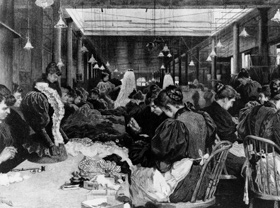Among the Poor Girls
By Wirt Sikes
Sikes, a popular social reformer in his day, worked with church groups and supported the efforts of the Working Women's Protective Union. First published in Putnam's Magazine, April 1868.
There are some roomy and cheerful shops in the city. But there are scores, and hundreds, that are not roomy and cheerful. The worst of these are owned and conducted by women. Look into this establishment, where Madame Fripperie, the fashionable dressmaker, holds her court. It is a handsome building, in one of the streets of the Fifteenth Ward. Hour on hour, throughout the day, the carriages of Fifth-avenue ladies drive up before her door. The liveried driver sits on the box waiting, while his liveried mistress trips up the steps, to consult with madame on the new silk contemplated, planned, or in progress.
While the momentous question is being discussed, let us slip down these stairs into the basement. This is the workroom. Faugh, how it smells! There is no attempt at ventilation. The room is crowded with girls and women, most of whom are pale and attenuated, and are being robbed of life slowly and surely. The rose which should bloom in their cheeks has vanished long ago. The sparkle has gone outof their eyes. They bend over their work with aching backs and throbbing brows; sharp pains dart through their eyeballs; they breathe an atmosphere of death. Madame pays her girls four dollars a week. She herself lives in as fine a style as the richest lady she serves.
And this is the story--a true one: Susie L_____ was a beautiful girl of seventeen, the daughter of a farmer in western New York. Her eyes were black and brilliant; her lips were red with rich life-blood of health; her complexion was pure pink and white, with such a lustrous, blooming freshness as is seldom seen, even among farmers' girls. Susie was a superior seamstress; her fingers were nimble, and her work always beautiful. Especially was she skillful in embroidery work; and in the old farm-house you may still see specimens of her handiwork, the pride of her mother and the wonder of the farmers' wives for miles about.
She came to New York to work and it was not long before she found employment in the shop last named above. The prices there paid are of the best that are paid in the city; Susie received a dollar a day. That she should get rich very soon, the girl felt sure; and it does not take much money to make a simple farmer's girl feel rich. It was two miles from her boarding-place to the shop; but such was her high health and strength, that she made nothing of walking this distance, morning and night.
Three months had not passed before she found her strength unequal to the task, and thereafter she rode to and fro in the streetcars. Dark lines had come under her eyes; her complexion was losing its color, her form its roundness and its springy life. In a word, the poison had entered her system, and was killing her by degrees. Still, in her pride, her anxiety to make the "old folks" happy--she had sent home to her father more than one welcome bank note--she concealed her sufferings, and struggled on.
One day she dropped from her chair heavily upon the floor of the dark, noisome apartment--was conveyed to her sister's home--and, when she left it again, a hearse stood at the door, and she was borne to her grave. She had not been one year absent from her country home.
Leon Stein, ed., Out of the Sweatshop: The Struggle for Industrial Democracy (New York: Quadrangle/New Times Book Company, 1977), pp. 12-13.
The Kheel Center would like to thank Mrs. Miriam Stein and Barbara Ismail for granting permission to use selections from the late Leon Stein's book.

